HRMT 131: Retention Bonuses and Compensation Management Analysis
VerifiedAdded on 2023/04/21
|11
|3448
|314
Report
AI Summary
This research paper examines the role and effectiveness of retention bonuses within the broader context of compensation management. The paper begins by defining compensation management and highlighting its role in attracting, retaining, and motivating employees. It then delves into the concept of retention bonuses, explaining their purpose, which is to incentivize key employees to remain with the company during critical periods such as mergers, acquisitions, or restructuring. The paper uses secondary data, including journal articles, official websites, and peer-reviewed journals, to analyze the effectiveness of retention bonuses as a strategy for employee retention. It explores various strategies companies use to retain employees, such as training programs, monitoring programs, and fostering a positive work environment. The paper also discusses the pros and cons of retention bonuses, including the costs associated with them, tax implications, and potential issues related to fairness and jealousy among employees. Furthermore, it emphasizes the importance of retention bonuses in the current business landscape, where pay-for-performance is increasingly prevalent. The paper concludes by highlighting the need for organizations to carefully consider retention arrangements to retain essential employees during periods of transition, taking into account their ability to contribute to a successful transition, their likelihood of seeking alternative employment, and their existing terms and conditions of employment.
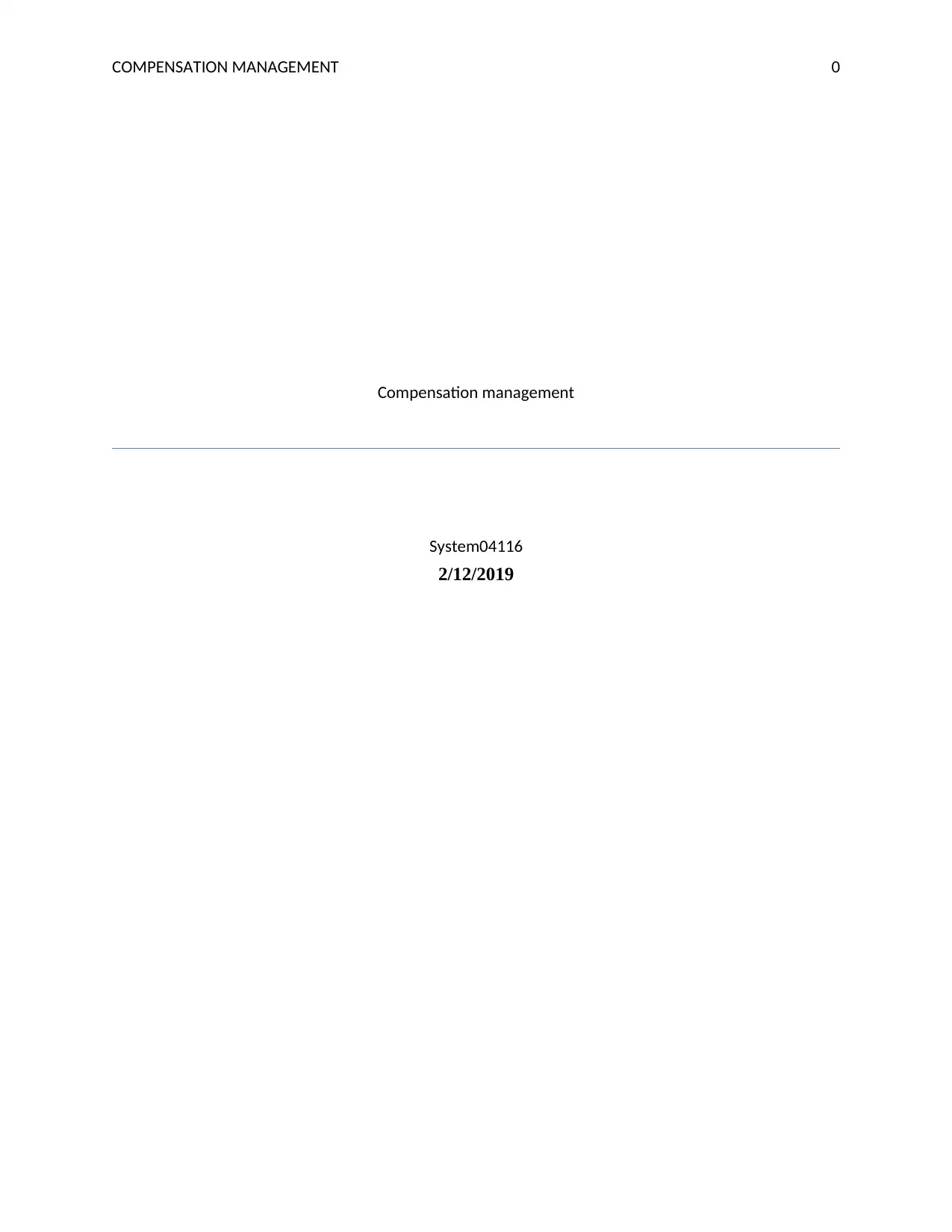
COMPENSATION MANAGEMENT 0
Compensation management
System04116
2/12/2019
Compensation management
System04116
2/12/2019
Paraphrase This Document
Need a fresh take? Get an instant paraphrase of this document with our AI Paraphraser
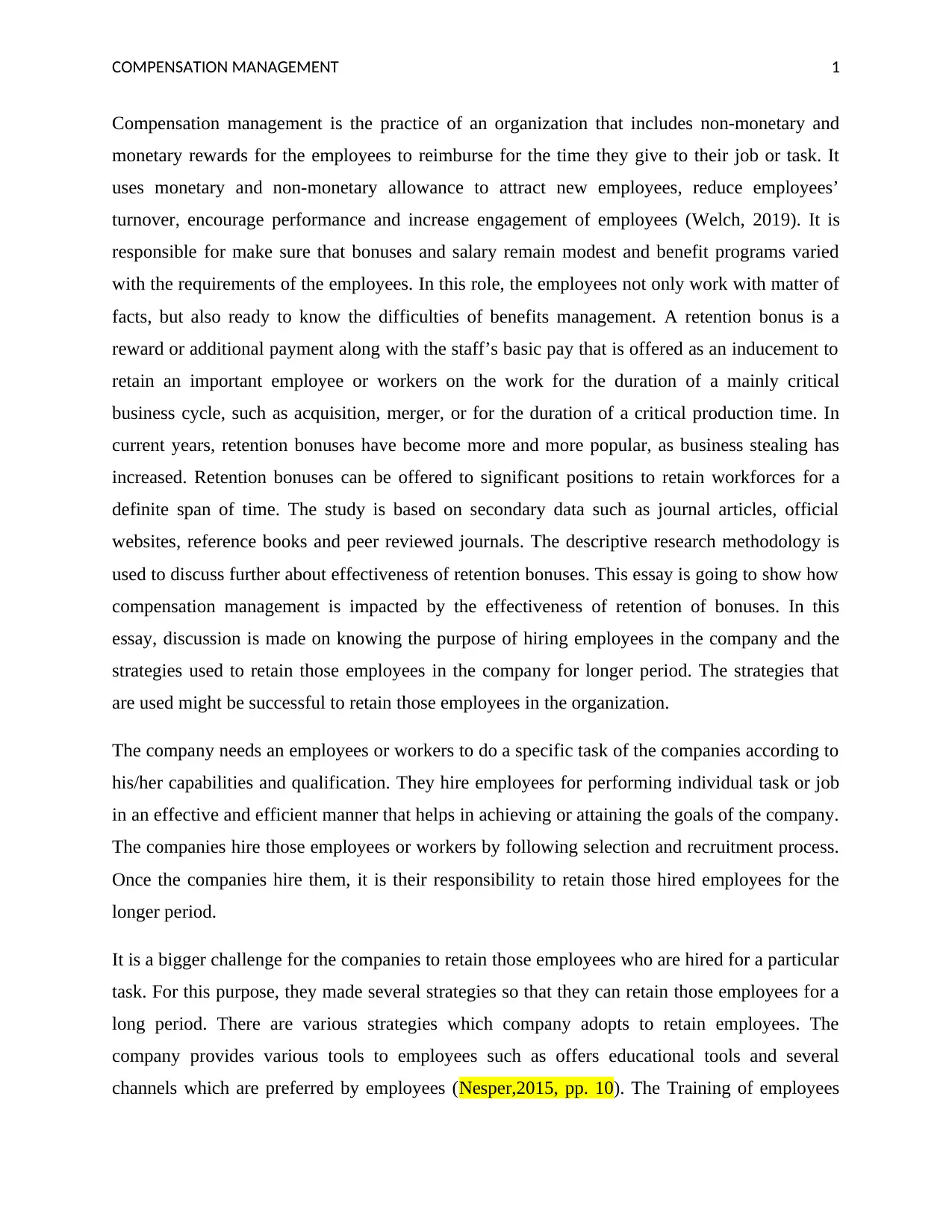
COMPENSATION MANAGEMENT 1
Compensation management is the practice of an organization that includes non-monetary and
monetary rewards for the employees to reimburse for the time they give to their job or task. It
uses monetary and non-monetary allowance to attract new employees, reduce employees’
turnover, encourage performance and increase engagement of employees (Welch, 2019). It is
responsible for make sure that bonuses and salary remain modest and benefit programs varied
with the requirements of the employees. In this role, the employees not only work with matter of
facts, but also ready to know the difficulties of benefits management. A retention bonus is a
reward or additional payment along with the staff’s basic pay that is offered as an inducement to
retain an important employee or workers on the work for the duration of a mainly critical
business cycle, such as acquisition, merger, or for the duration of a critical production time. In
current years, retention bonuses have become more and more popular, as business stealing has
increased. Retention bonuses can be offered to significant positions to retain workforces for a
definite span of time. The study is based on secondary data such as journal articles, official
websites, reference books and peer reviewed journals. The descriptive research methodology is
used to discuss further about effectiveness of retention bonuses. This essay is going to show how
compensation management is impacted by the effectiveness of retention of bonuses. In this
essay, discussion is made on knowing the purpose of hiring employees in the company and the
strategies used to retain those employees in the company for longer period. The strategies that
are used might be successful to retain those employees in the organization.
The company needs an employees or workers to do a specific task of the companies according to
his/her capabilities and qualification. They hire employees for performing individual task or job
in an effective and efficient manner that helps in achieving or attaining the goals of the company.
The companies hire those employees or workers by following selection and recruitment process.
Once the companies hire them, it is their responsibility to retain those hired employees for the
longer period.
It is a bigger challenge for the companies to retain those employees who are hired for a particular
task. For this purpose, they made several strategies so that they can retain those employees for a
long period. There are various strategies which company adopts to retain employees. The
company provides various tools to employees such as offers educational tools and several
channels which are preferred by employees (Nesper,2015, pp. 10). The Training of employees
Compensation management is the practice of an organization that includes non-monetary and
monetary rewards for the employees to reimburse for the time they give to their job or task. It
uses monetary and non-monetary allowance to attract new employees, reduce employees’
turnover, encourage performance and increase engagement of employees (Welch, 2019). It is
responsible for make sure that bonuses and salary remain modest and benefit programs varied
with the requirements of the employees. In this role, the employees not only work with matter of
facts, but also ready to know the difficulties of benefits management. A retention bonus is a
reward or additional payment along with the staff’s basic pay that is offered as an inducement to
retain an important employee or workers on the work for the duration of a mainly critical
business cycle, such as acquisition, merger, or for the duration of a critical production time. In
current years, retention bonuses have become more and more popular, as business stealing has
increased. Retention bonuses can be offered to significant positions to retain workforces for a
definite span of time. The study is based on secondary data such as journal articles, official
websites, reference books and peer reviewed journals. The descriptive research methodology is
used to discuss further about effectiveness of retention bonuses. This essay is going to show how
compensation management is impacted by the effectiveness of retention of bonuses. In this
essay, discussion is made on knowing the purpose of hiring employees in the company and the
strategies used to retain those employees in the company for longer period. The strategies that
are used might be successful to retain those employees in the organization.
The company needs an employees or workers to do a specific task of the companies according to
his/her capabilities and qualification. They hire employees for performing individual task or job
in an effective and efficient manner that helps in achieving or attaining the goals of the company.
The companies hire those employees or workers by following selection and recruitment process.
Once the companies hire them, it is their responsibility to retain those hired employees for the
longer period.
It is a bigger challenge for the companies to retain those employees who are hired for a particular
task. For this purpose, they made several strategies so that they can retain those employees for a
long period. There are various strategies which company adopts to retain employees. The
company provides various tools to employees such as offers educational tools and several
channels which are preferred by employees (Nesper,2015, pp. 10). The Training of employees

COMPENSATION MANAGEMENT 2
strengthens their intelligence or sense of value. With the help of training, managers or
supervisors help staffs to achieve goals or objectives and confirm they have a strong
understanding of their work requirements. A monitoring program is a strong foundation for key
employee’s growth and retention. As it is, combined with the goal-oriented feedback system, that
makes available an organized apparatus for emerging sturdy relationship within an organization.
With the help of monitoring program, an organization combines those people who have
experienced in a discipline with those people who are less experienced in a related area, with the
aim to improve specific competencies, be responsible for performance feedback, and construct a
personalized career improvement plan. An organization should form a value series as the
foundation for culture like attitude, excellence, morality, teamwork and respect. An organization,
which creates the right culture, will attract and keep key employees. Communication is essential
to build and maintain credibility in every organization. Through a staff advisory council, various
companies get communication to flow up that asks and takes employee’s views and ideas and
points them on to higher management. It is also essential for staffs to understand that the
employer is truly listening and revert to staffs input. An offering like good salaries, sharing of
profits, programs for bonuses, paid time off, health plan and pension and training compensation
directs an influential note to staffs about their prominence at the organization. The payments or
rewards offered to staffs should be expressive with the aim to encourage their awareness of an
organization and thus it has clear impact on its efforts of holding. Moreover, if the organization
promises that they will give rewards for employee’s efforts then it is their responsibility to keep
that promise. Employees performance reflects the performance of an organization (Ajang, 2014).
Having current employees offer appointment helps in minimizing the misperception of job or
work expectations. Present workforces can credibly define a position and the situation to appoint
from within; meanwhile current employees have previously learnt that they are virtuous for the
organization. It is essential for an organization to give response and training to staffs so that the
efforts of staff remain associated with the aims of an organization and meet prospects or
expectancy. An employer should be responsible for intensive response during initial few weeks
on the job of the employees. Employers throughout the year should provide employees formal
and informal responses. An organization should arrange for workshops, software or other
apparatuses to help staffs increase their knowing power of themselves, clear about their wants
from profession, and increase their setting of goals efforts. It is necessary to provide staffs with
strengthens their intelligence or sense of value. With the help of training, managers or
supervisors help staffs to achieve goals or objectives and confirm they have a strong
understanding of their work requirements. A monitoring program is a strong foundation for key
employee’s growth and retention. As it is, combined with the goal-oriented feedback system, that
makes available an organized apparatus for emerging sturdy relationship within an organization.
With the help of monitoring program, an organization combines those people who have
experienced in a discipline with those people who are less experienced in a related area, with the
aim to improve specific competencies, be responsible for performance feedback, and construct a
personalized career improvement plan. An organization should form a value series as the
foundation for culture like attitude, excellence, morality, teamwork and respect. An organization,
which creates the right culture, will attract and keep key employees. Communication is essential
to build and maintain credibility in every organization. Through a staff advisory council, various
companies get communication to flow up that asks and takes employee’s views and ideas and
points them on to higher management. It is also essential for staffs to understand that the
employer is truly listening and revert to staffs input. An offering like good salaries, sharing of
profits, programs for bonuses, paid time off, health plan and pension and training compensation
directs an influential note to staffs about their prominence at the organization. The payments or
rewards offered to staffs should be expressive with the aim to encourage their awareness of an
organization and thus it has clear impact on its efforts of holding. Moreover, if the organization
promises that they will give rewards for employee’s efforts then it is their responsibility to keep
that promise. Employees performance reflects the performance of an organization (Ajang, 2014).
Having current employees offer appointment helps in minimizing the misperception of job or
work expectations. Present workforces can credibly define a position and the situation to appoint
from within; meanwhile current employees have previously learnt that they are virtuous for the
organization. It is essential for an organization to give response and training to staffs so that the
efforts of staff remain associated with the aims of an organization and meet prospects or
expectancy. An employer should be responsible for intensive response during initial few weeks
on the job of the employees. Employers throughout the year should provide employees formal
and informal responses. An organization should arrange for workshops, software or other
apparatuses to help staffs increase their knowing power of themselves, clear about their wants
from profession, and increase their setting of goals efforts. It is necessary to provide staffs with
⊘ This is a preview!⊘
Do you want full access?
Subscribe today to unlock all pages.

Trusted by 1+ million students worldwide
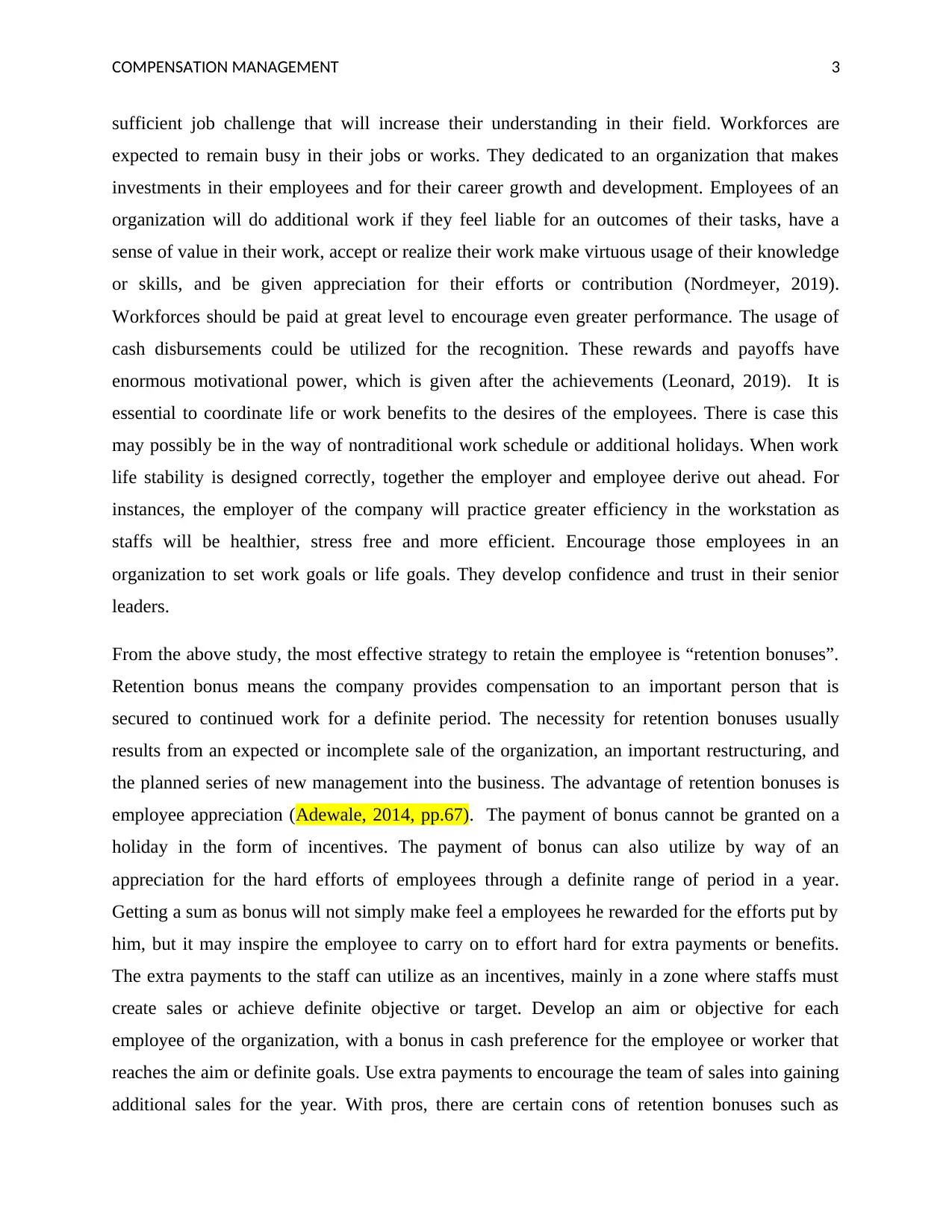
COMPENSATION MANAGEMENT 3
sufficient job challenge that will increase their understanding in their field. Workforces are
expected to remain busy in their jobs or works. They dedicated to an organization that makes
investments in their employees and for their career growth and development. Employees of an
organization will do additional work if they feel liable for an outcomes of their tasks, have a
sense of value in their work, accept or realize their work make virtuous usage of their knowledge
or skills, and be given appreciation for their efforts or contribution (Nordmeyer, 2019).
Workforces should be paid at great level to encourage even greater performance. The usage of
cash disbursements could be utilized for the recognition. These rewards and payoffs have
enormous motivational power, which is given after the achievements (Leonard, 2019). It is
essential to coordinate life or work benefits to the desires of the employees. There is case this
may possibly be in the way of nontraditional work schedule or additional holidays. When work
life stability is designed correctly, together the employer and employee derive out ahead. For
instances, the employer of the company will practice greater efficiency in the workstation as
staffs will be healthier, stress free and more efficient. Encourage those employees in an
organization to set work goals or life goals. They develop confidence and trust in their senior
leaders.
From the above study, the most effective strategy to retain the employee is “retention bonuses”.
Retention bonus means the company provides compensation to an important person that is
secured to continued work for a definite period. The necessity for retention bonuses usually
results from an expected or incomplete sale of the organization, an important restructuring, and
the planned series of new management into the business. The advantage of retention bonuses is
employee appreciation (Adewale, 2014, pp.67). The payment of bonus cannot be granted on a
holiday in the form of incentives. The payment of bonus can also utilize by way of an
appreciation for the hard efforts of employees through a definite range of period in a year.
Getting a sum as bonus will not simply make feel a employees he rewarded for the efforts put by
him, but it may inspire the employee to carry on to effort hard for extra payments or benefits.
The extra payments to the staff can utilize as an incentives, mainly in a zone where staffs must
create sales or achieve definite objective or target. Develop an aim or objective for each
employee of the organization, with a bonus in cash preference for the employee or worker that
reaches the aim or definite goals. Use extra payments to encourage the team of sales into gaining
additional sales for the year. With pros, there are certain cons of retention bonuses such as
sufficient job challenge that will increase their understanding in their field. Workforces are
expected to remain busy in their jobs or works. They dedicated to an organization that makes
investments in their employees and for their career growth and development. Employees of an
organization will do additional work if they feel liable for an outcomes of their tasks, have a
sense of value in their work, accept or realize their work make virtuous usage of their knowledge
or skills, and be given appreciation for their efforts or contribution (Nordmeyer, 2019).
Workforces should be paid at great level to encourage even greater performance. The usage of
cash disbursements could be utilized for the recognition. These rewards and payoffs have
enormous motivational power, which is given after the achievements (Leonard, 2019). It is
essential to coordinate life or work benefits to the desires of the employees. There is case this
may possibly be in the way of nontraditional work schedule or additional holidays. When work
life stability is designed correctly, together the employer and employee derive out ahead. For
instances, the employer of the company will practice greater efficiency in the workstation as
staffs will be healthier, stress free and more efficient. Encourage those employees in an
organization to set work goals or life goals. They develop confidence and trust in their senior
leaders.
From the above study, the most effective strategy to retain the employee is “retention bonuses”.
Retention bonus means the company provides compensation to an important person that is
secured to continued work for a definite period. The necessity for retention bonuses usually
results from an expected or incomplete sale of the organization, an important restructuring, and
the planned series of new management into the business. The advantage of retention bonuses is
employee appreciation (Adewale, 2014, pp.67). The payment of bonus cannot be granted on a
holiday in the form of incentives. The payment of bonus can also utilize by way of an
appreciation for the hard efforts of employees through a definite range of period in a year.
Getting a sum as bonus will not simply make feel a employees he rewarded for the efforts put by
him, but it may inspire the employee to carry on to effort hard for extra payments or benefits.
The extra payments to the staff can utilize as an incentives, mainly in a zone where staffs must
create sales or achieve definite objective or target. Develop an aim or objective for each
employee of the organization, with a bonus in cash preference for the employee or worker that
reaches the aim or definite goals. Use extra payments to encourage the team of sales into gaining
additional sales for the year. With pros, there are certain cons of retention bonuses such as
Paraphrase This Document
Need a fresh take? Get an instant paraphrase of this document with our AI Paraphraser
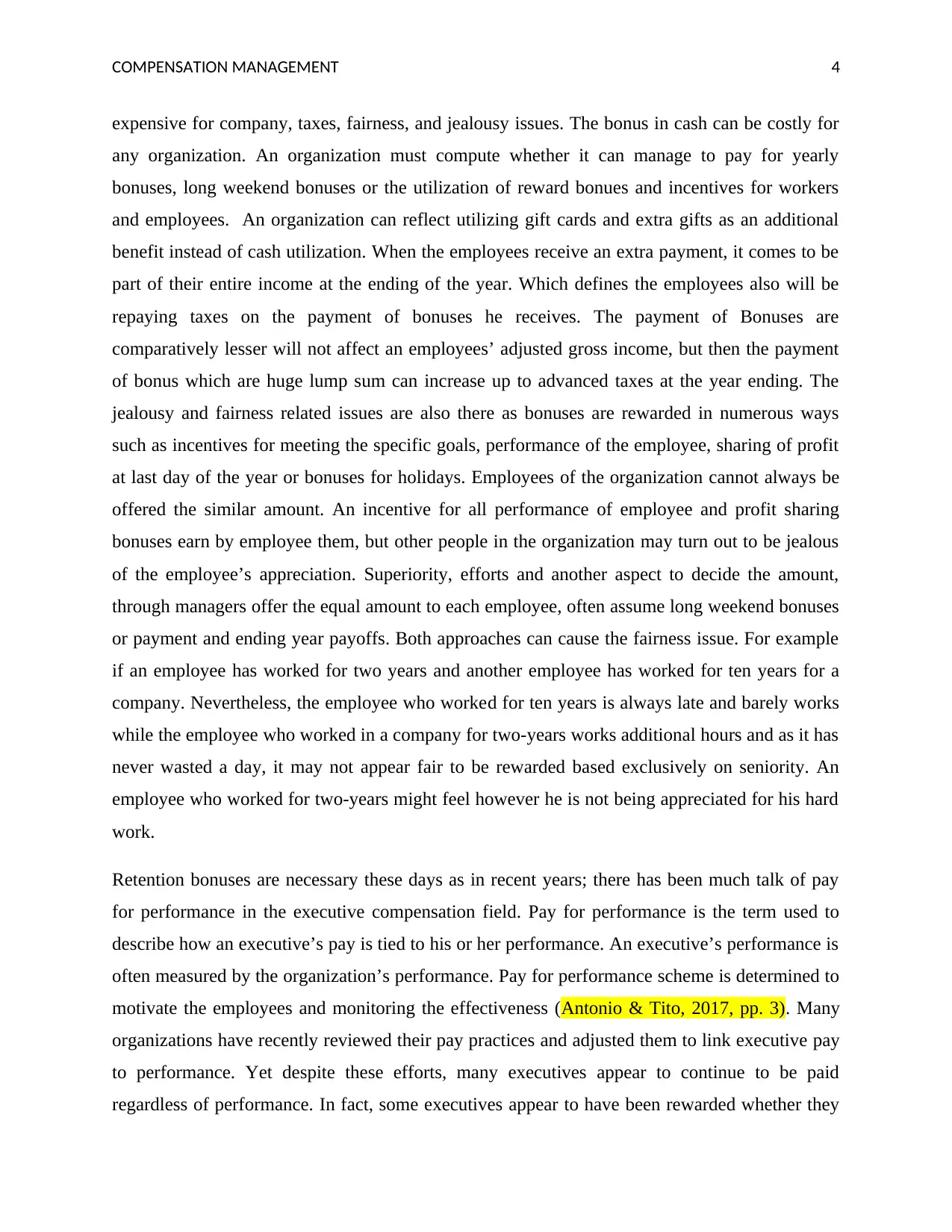
COMPENSATION MANAGEMENT 4
expensive for company, taxes, fairness, and jealousy issues. The bonus in cash can be costly for
any organization. An organization must compute whether it can manage to pay for yearly
bonuses, long weekend bonuses or the utilization of reward bonues and incentives for workers
and employees. An organization can reflect utilizing gift cards and extra gifts as an additional
benefit instead of cash utilization. When the employees receive an extra payment, it comes to be
part of their entire income at the ending of the year. Which defines the employees also will be
repaying taxes on the payment of bonuses he receives. The payment of Bonuses are
comparatively lesser will not affect an employees’ adjusted gross income, but then the payment
of bonus which are huge lump sum can increase up to advanced taxes at the year ending. The
jealousy and fairness related issues are also there as bonuses are rewarded in numerous ways
such as incentives for meeting the specific goals, performance of the employee, sharing of profit
at last day of the year or bonuses for holidays. Employees of the organization cannot always be
offered the similar amount. An incentive for all performance of employee and profit sharing
bonuses earn by employee them, but other people in the organization may turn out to be jealous
of the employee’s appreciation. Superiority, efforts and another aspect to decide the amount,
through managers offer the equal amount to each employee, often assume long weekend bonuses
or payment and ending year payoffs. Both approaches can cause the fairness issue. For example
if an employee has worked for two years and another employee has worked for ten years for a
company. Nevertheless, the employee who worked for ten years is always late and barely works
while the employee who worked in a company for two-years works additional hours and as it has
never wasted a day, it may not appear fair to be rewarded based exclusively on seniority. An
employee who worked for two-years might feel however he is not being appreciated for his hard
work.
Retention bonuses are necessary these days as in recent years; there has been much talk of pay
for performance in the executive compensation field. Pay for performance is the term used to
describe how an executive’s pay is tied to his or her performance. An executive’s performance is
often measured by the organization’s performance. Pay for performance scheme is determined to
motivate the employees and monitoring the effectiveness (Antonio & Tito, 2017, pp. 3). Many
organizations have recently reviewed their pay practices and adjusted them to link executive pay
to performance. Yet despite these efforts, many executives appear to continue to be paid
regardless of performance. In fact, some executives appear to have been rewarded whether they
expensive for company, taxes, fairness, and jealousy issues. The bonus in cash can be costly for
any organization. An organization must compute whether it can manage to pay for yearly
bonuses, long weekend bonuses or the utilization of reward bonues and incentives for workers
and employees. An organization can reflect utilizing gift cards and extra gifts as an additional
benefit instead of cash utilization. When the employees receive an extra payment, it comes to be
part of their entire income at the ending of the year. Which defines the employees also will be
repaying taxes on the payment of bonuses he receives. The payment of Bonuses are
comparatively lesser will not affect an employees’ adjusted gross income, but then the payment
of bonus which are huge lump sum can increase up to advanced taxes at the year ending. The
jealousy and fairness related issues are also there as bonuses are rewarded in numerous ways
such as incentives for meeting the specific goals, performance of the employee, sharing of profit
at last day of the year or bonuses for holidays. Employees of the organization cannot always be
offered the similar amount. An incentive for all performance of employee and profit sharing
bonuses earn by employee them, but other people in the organization may turn out to be jealous
of the employee’s appreciation. Superiority, efforts and another aspect to decide the amount,
through managers offer the equal amount to each employee, often assume long weekend bonuses
or payment and ending year payoffs. Both approaches can cause the fairness issue. For example
if an employee has worked for two years and another employee has worked for ten years for a
company. Nevertheless, the employee who worked for ten years is always late and barely works
while the employee who worked in a company for two-years works additional hours and as it has
never wasted a day, it may not appear fair to be rewarded based exclusively on seniority. An
employee who worked for two-years might feel however he is not being appreciated for his hard
work.
Retention bonuses are necessary these days as in recent years; there has been much talk of pay
for performance in the executive compensation field. Pay for performance is the term used to
describe how an executive’s pay is tied to his or her performance. An executive’s performance is
often measured by the organization’s performance. Pay for performance scheme is determined to
motivate the employees and monitoring the effectiveness (Antonio & Tito, 2017, pp. 3). Many
organizations have recently reviewed their pay practices and adjusted them to link executive pay
to performance. Yet despite these efforts, many executives appear to continue to be paid
regardless of performance. In fact, some executives appear to have been rewarded whether they
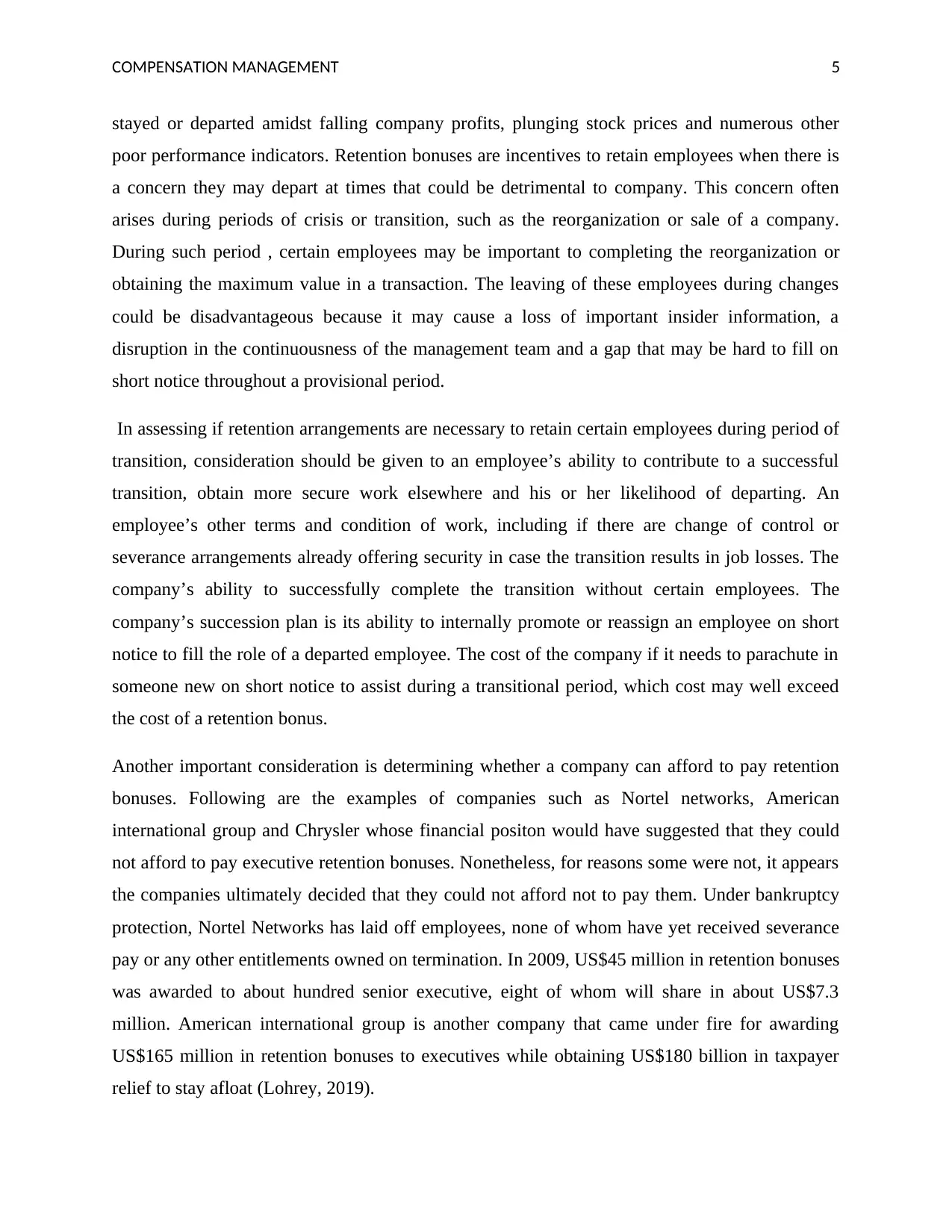
COMPENSATION MANAGEMENT 5
stayed or departed amidst falling company profits, plunging stock prices and numerous other
poor performance indicators. Retention bonuses are incentives to retain employees when there is
a concern they may depart at times that could be detrimental to company. This concern often
arises during periods of crisis or transition, such as the reorganization or sale of a company.
During such period , certain employees may be important to completing the reorganization or
obtaining the maximum value in a transaction. The leaving of these employees during changes
could be disadvantageous because it may cause a loss of important insider information, a
disruption in the continuousness of the management team and a gap that may be hard to fill on
short notice throughout a provisional period.
In assessing if retention arrangements are necessary to retain certain employees during period of
transition, consideration should be given to an employee’s ability to contribute to a successful
transition, obtain more secure work elsewhere and his or her likelihood of departing. An
employee’s other terms and condition of work, including if there are change of control or
severance arrangements already offering security in case the transition results in job losses. The
company’s ability to successfully complete the transition without certain employees. The
company’s succession plan is its ability to internally promote or reassign an employee on short
notice to fill the role of a departed employee. The cost of the company if it needs to parachute in
someone new on short notice to assist during a transitional period, which cost may well exceed
the cost of a retention bonus.
Another important consideration is determining whether a company can afford to pay retention
bonuses. Following are the examples of companies such as Nortel networks, American
international group and Chrysler whose financial positon would have suggested that they could
not afford to pay executive retention bonuses. Nonetheless, for reasons some were not, it appears
the companies ultimately decided that they could not afford not to pay them. Under bankruptcy
protection, Nortel Networks has laid off employees, none of whom have yet received severance
pay or any other entitlements owned on termination. In 2009, US$45 million in retention bonuses
was awarded to about hundred senior executive, eight of whom will share in about US$7.3
million. American international group is another company that came under fire for awarding
US$165 million in retention bonuses to executives while obtaining US$180 billion in taxpayer
relief to stay afloat (Lohrey, 2019).
stayed or departed amidst falling company profits, plunging stock prices and numerous other
poor performance indicators. Retention bonuses are incentives to retain employees when there is
a concern they may depart at times that could be detrimental to company. This concern often
arises during periods of crisis or transition, such as the reorganization or sale of a company.
During such period , certain employees may be important to completing the reorganization or
obtaining the maximum value in a transaction. The leaving of these employees during changes
could be disadvantageous because it may cause a loss of important insider information, a
disruption in the continuousness of the management team and a gap that may be hard to fill on
short notice throughout a provisional period.
In assessing if retention arrangements are necessary to retain certain employees during period of
transition, consideration should be given to an employee’s ability to contribute to a successful
transition, obtain more secure work elsewhere and his or her likelihood of departing. An
employee’s other terms and condition of work, including if there are change of control or
severance arrangements already offering security in case the transition results in job losses. The
company’s ability to successfully complete the transition without certain employees. The
company’s succession plan is its ability to internally promote or reassign an employee on short
notice to fill the role of a departed employee. The cost of the company if it needs to parachute in
someone new on short notice to assist during a transitional period, which cost may well exceed
the cost of a retention bonus.
Another important consideration is determining whether a company can afford to pay retention
bonuses. Following are the examples of companies such as Nortel networks, American
international group and Chrysler whose financial positon would have suggested that they could
not afford to pay executive retention bonuses. Nonetheless, for reasons some were not, it appears
the companies ultimately decided that they could not afford not to pay them. Under bankruptcy
protection, Nortel Networks has laid off employees, none of whom have yet received severance
pay or any other entitlements owned on termination. In 2009, US$45 million in retention bonuses
was awarded to about hundred senior executive, eight of whom will share in about US$7.3
million. American international group is another company that came under fire for awarding
US$165 million in retention bonuses to executives while obtaining US$180 billion in taxpayer
relief to stay afloat (Lohrey, 2019).
⊘ This is a preview!⊘
Do you want full access?
Subscribe today to unlock all pages.

Trusted by 1+ million students worldwide

COMPENSATION MANAGEMENT 6
Therefore, there are many strategies made to retain key employees in the company but the most
effective strategy is retention bonuses. The effectiveness of retention bonuses is, it helps in
retaining employees for longer period and motivates them to work effectively and efficiently.
The retention bonus offerings are an effective tactics for holding critical personnel. Bonus is a
significant part for many companies’ employees. Bonuses have both positive and negative effect
on retention. Some organizations will have optimistic outcomes with bonuses. The bonuses
motivate employees of an organization to work harder. In order to offer additional pay as
successfully as possible, it is best to offer them with good reason. The retention bonus is
effective in recognizing and rewarding contribution of employee towards organization
profitability, safety, productivity, quality, teamwork, or some other metric considered significant
by senior leaders or high-ranking personnel (Chuck, 2016, pp. 5). The employee or worker is
given retention bonus has gone athwart his or her work description to contribute to organization’
success. Bonuses are provided in a multiplicity of formats comprising sharing of profits, cash,
long weekend bonus, bonuses, delayed compensation, goods, and services such as an
organization paid trip or a thanksgiving turkey.
It is concluded that retention bonus is effective for retaining employees in the organization for
longer period and achieve objective of the company. Though there are various other tactics used
to retain employees in the organization but retention bonus is effective one for this purpose.
Employees get motivated when they get bonus in the form of cash, holiday bonus, profit sharing,
deferred compensation, cash, goods and services. Some companies who failed to offer retention
bonuses face the turnover of key employees. The companies need to provide retention bonuses to
achieve their company goals and effective and efficient work from employees. During crucial
business cycle, key personnel are needed for overcoming the problems by giving extra work
hours for that particular task. The appreciation must be given to those key personnel for their
work in the form of bonuses or extra pay. This will helps in retaining those key personnel for
long period and motivate them to work hard towards the goals of the company. The various
disadvantages are also observed from retention bonuses such as fairness and jealousy issues
among employees of the organization. Compounding the problem is that transitional periods are
precisely when a company’s most valuable employees often look for more secure work
elsewhere, particularly if there is a high risk the transition may result in the loss of their jobs. As
such, many organizations implement retention programs during periods of transition to ensure
Therefore, there are many strategies made to retain key employees in the company but the most
effective strategy is retention bonuses. The effectiveness of retention bonuses is, it helps in
retaining employees for longer period and motivates them to work effectively and efficiently.
The retention bonus offerings are an effective tactics for holding critical personnel. Bonus is a
significant part for many companies’ employees. Bonuses have both positive and negative effect
on retention. Some organizations will have optimistic outcomes with bonuses. The bonuses
motivate employees of an organization to work harder. In order to offer additional pay as
successfully as possible, it is best to offer them with good reason. The retention bonus is
effective in recognizing and rewarding contribution of employee towards organization
profitability, safety, productivity, quality, teamwork, or some other metric considered significant
by senior leaders or high-ranking personnel (Chuck, 2016, pp. 5). The employee or worker is
given retention bonus has gone athwart his or her work description to contribute to organization’
success. Bonuses are provided in a multiplicity of formats comprising sharing of profits, cash,
long weekend bonus, bonuses, delayed compensation, goods, and services such as an
organization paid trip or a thanksgiving turkey.
It is concluded that retention bonus is effective for retaining employees in the organization for
longer period and achieve objective of the company. Though there are various other tactics used
to retain employees in the organization but retention bonus is effective one for this purpose.
Employees get motivated when they get bonus in the form of cash, holiday bonus, profit sharing,
deferred compensation, cash, goods and services. Some companies who failed to offer retention
bonuses face the turnover of key employees. The companies need to provide retention bonuses to
achieve their company goals and effective and efficient work from employees. During crucial
business cycle, key personnel are needed for overcoming the problems by giving extra work
hours for that particular task. The appreciation must be given to those key personnel for their
work in the form of bonuses or extra pay. This will helps in retaining those key personnel for
long period and motivate them to work hard towards the goals of the company. The various
disadvantages are also observed from retention bonuses such as fairness and jealousy issues
among employees of the organization. Compounding the problem is that transitional periods are
precisely when a company’s most valuable employees often look for more secure work
elsewhere, particularly if there is a high risk the transition may result in the loss of their jobs. As
such, many organizations implement retention programs during periods of transition to ensure
Paraphrase This Document
Need a fresh take? Get an instant paraphrase of this document with our AI Paraphraser
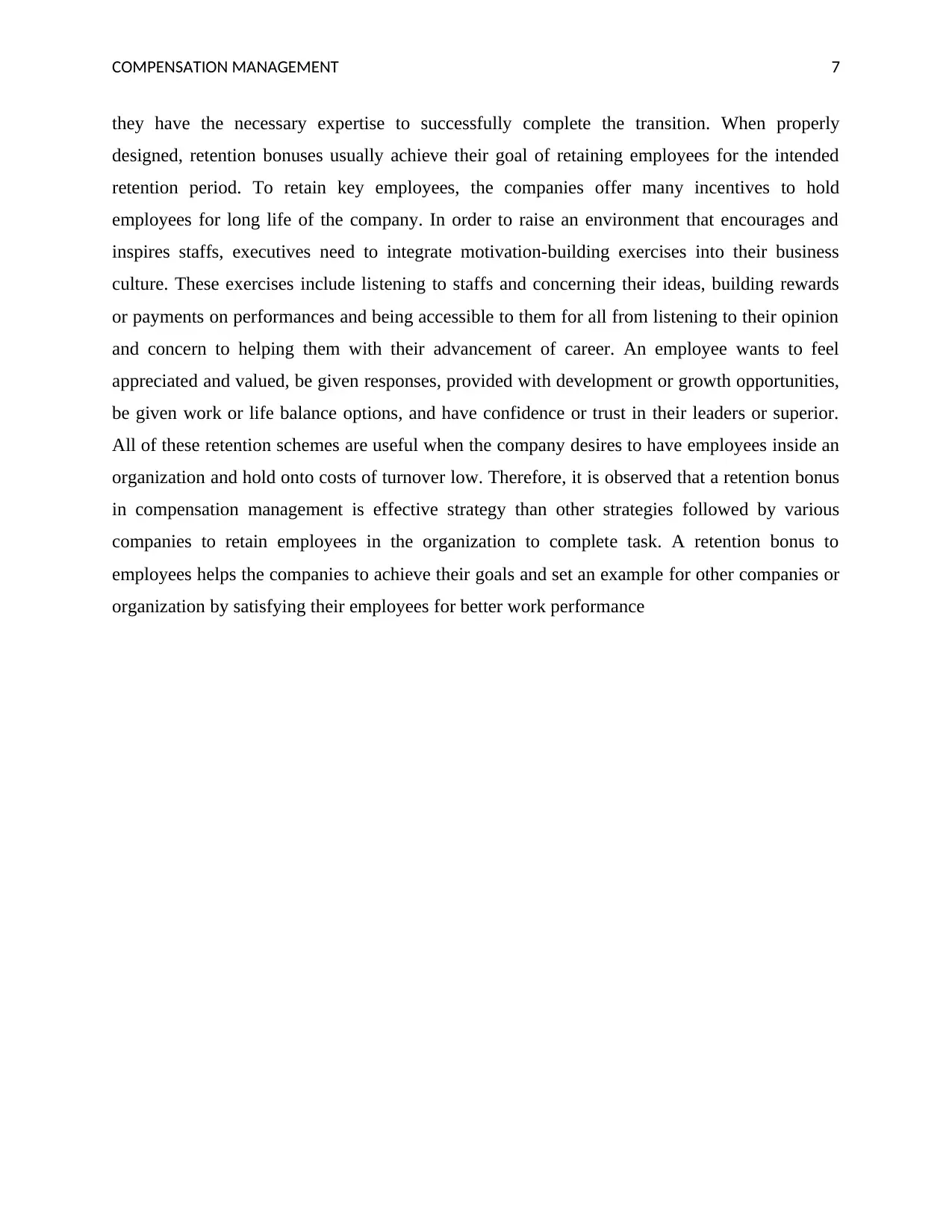
COMPENSATION MANAGEMENT 7
they have the necessary expertise to successfully complete the transition. When properly
designed, retention bonuses usually achieve their goal of retaining employees for the intended
retention period. To retain key employees, the companies offer many incentives to hold
employees for long life of the company. In order to raise an environment that encourages and
inspires staffs, executives need to integrate motivation-building exercises into their business
culture. These exercises include listening to staffs and concerning their ideas, building rewards
or payments on performances and being accessible to them for all from listening to their opinion
and concern to helping them with their advancement of career. An employee wants to feel
appreciated and valued, be given responses, provided with development or growth opportunities,
be given work or life balance options, and have confidence or trust in their leaders or superior.
All of these retention schemes are useful when the company desires to have employees inside an
organization and hold onto costs of turnover low. Therefore, it is observed that a retention bonus
in compensation management is effective strategy than other strategies followed by various
companies to retain employees in the organization to complete task. A retention bonus to
employees helps the companies to achieve their goals and set an example for other companies or
organization by satisfying their employees for better work performance
they have the necessary expertise to successfully complete the transition. When properly
designed, retention bonuses usually achieve their goal of retaining employees for the intended
retention period. To retain key employees, the companies offer many incentives to hold
employees for long life of the company. In order to raise an environment that encourages and
inspires staffs, executives need to integrate motivation-building exercises into their business
culture. These exercises include listening to staffs and concerning their ideas, building rewards
or payments on performances and being accessible to them for all from listening to their opinion
and concern to helping them with their advancement of career. An employee wants to feel
appreciated and valued, be given responses, provided with development or growth opportunities,
be given work or life balance options, and have confidence or trust in their leaders or superior.
All of these retention schemes are useful when the company desires to have employees inside an
organization and hold onto costs of turnover low. Therefore, it is observed that a retention bonus
in compensation management is effective strategy than other strategies followed by various
companies to retain employees in the organization to complete task. A retention bonus to
employees helps the companies to achieve their goals and set an example for other companies or
organization by satisfying their employees for better work performance

COMPENSATION MANAGEMENT 8
References
Adewale. O. T. (2014). Compensation packages: a strategic tool for employees' performance
and retention. Leonardo Journal of Sciences, 25(1), 65-84.
Ajang, R. (2014). Human resource management: Reward and compensation. Retrieved from:
https://www.slideshare.net/reefearajang/human-resource-management-reward-
and-compensation
Antonio, C. & Tito, C. (2017). Motivations, monitoring technologies, and pay for performance.
Economic behavior and organization, 133(1), 236-255.
Chuck, C., (2016). Using bonus and awards for motivating project employees. Human resource
management international digest, 24(7), 4-7.
Leonard, K. (2019). Importance of compensation at the workplace. Retrieved from:
https://smallbusiness.chron.com/importance-compensation-workplace-38470.html
Lohrey, J. (2019). How much do most companies pay in retention bonuses?. Retrieved from:
https://smallbusiness.chron.com/much-companies-pay-retention-bonuses-
80833.html
Nesper, M. (2015). Employee retention: the more benefits, the happier the employee; retaining
employees cited as main objective in offering benefits, says new metlife study.
Employee benefit news, 29(8), 10.
Nordmeyer, B. (2019). Challenges of employee retention. Retrieved from:
https://work.chron.com/challenges-employee-retention-2428.html
Welch, J. (2019). Compensation management. Retrieved from:
https://www.managementstudyguide.com/compensation-management.htm
References
Adewale. O. T. (2014). Compensation packages: a strategic tool for employees' performance
and retention. Leonardo Journal of Sciences, 25(1), 65-84.
Ajang, R. (2014). Human resource management: Reward and compensation. Retrieved from:
https://www.slideshare.net/reefearajang/human-resource-management-reward-
and-compensation
Antonio, C. & Tito, C. (2017). Motivations, monitoring technologies, and pay for performance.
Economic behavior and organization, 133(1), 236-255.
Chuck, C., (2016). Using bonus and awards for motivating project employees. Human resource
management international digest, 24(7), 4-7.
Leonard, K. (2019). Importance of compensation at the workplace. Retrieved from:
https://smallbusiness.chron.com/importance-compensation-workplace-38470.html
Lohrey, J. (2019). How much do most companies pay in retention bonuses?. Retrieved from:
https://smallbusiness.chron.com/much-companies-pay-retention-bonuses-
80833.html
Nesper, M. (2015). Employee retention: the more benefits, the happier the employee; retaining
employees cited as main objective in offering benefits, says new metlife study.
Employee benefit news, 29(8), 10.
Nordmeyer, B. (2019). Challenges of employee retention. Retrieved from:
https://work.chron.com/challenges-employee-retention-2428.html
Welch, J. (2019). Compensation management. Retrieved from:
https://www.managementstudyguide.com/compensation-management.htm
⊘ This is a preview!⊘
Do you want full access?
Subscribe today to unlock all pages.

Trusted by 1+ million students worldwide

COMPENSATION MANAGEMENT 9
Paraphrase This Document
Need a fresh take? Get an instant paraphrase of this document with our AI Paraphraser

COMPENSATION MANAGEMENT 10
1 out of 11
Related Documents
Your All-in-One AI-Powered Toolkit for Academic Success.
+13062052269
info@desklib.com
Available 24*7 on WhatsApp / Email
![[object Object]](/_next/static/media/star-bottom.7253800d.svg)
Unlock your academic potential
Copyright © 2020–2025 A2Z Services. All Rights Reserved. Developed and managed by ZUCOL.




